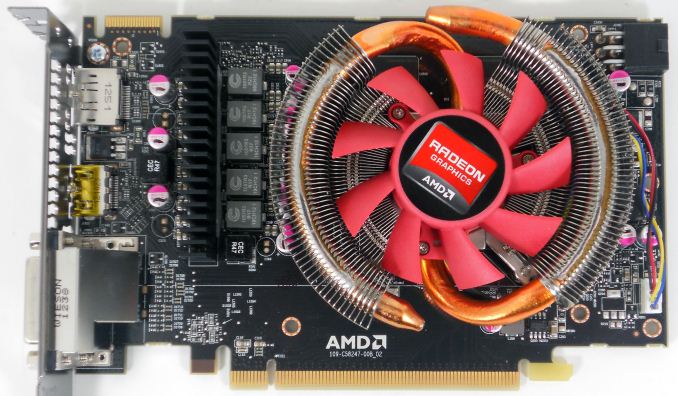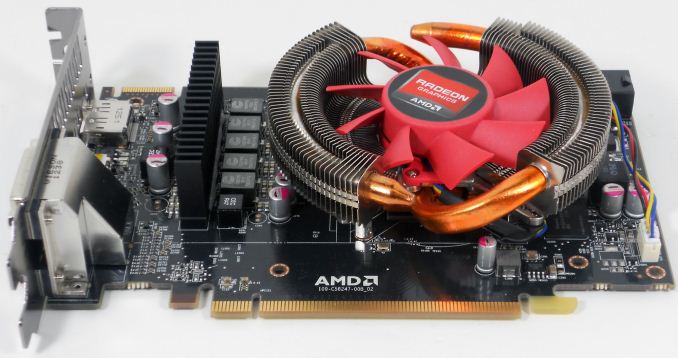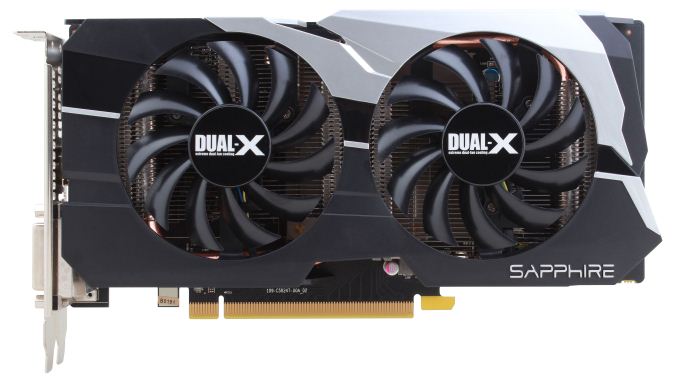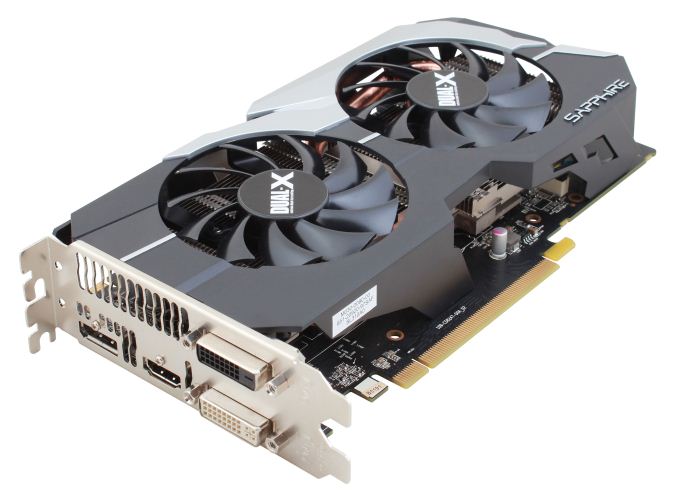AMD Radeon HD 7790 Review Feat. Sapphire: The First Desktop Sea Islands
by Ryan Smith on March 22, 2013 12:01 AM EST- Posted in
- GPUs
- AMD
- Sapphire
- GCN
- Radeon HD 7000
Meet The Radeon HD 7790 & Sapphire HD 7790 Dual-X Turbo
Today we’ll be looking at two cards, AMD’s reference card and Sapphire’s customized HD 7790 Dual-X OC. As is typical for cards in this price segment, the designs are relatively simple and as such only a few partners will be using the reference design as opposed to rolling their own designs. At the same time AMD is pushing their partners’ factory overclocked cards hard – we have the Sapphire and then 3 more on their way – but it’s important to keep in mind that not every last 7790 will be factory overclocked. So AMD’s Spartan reference card is a good example of baseline 7790 performance will be like, including how well it performs with a simple, single-fan open air cooler.
As we alluded to a moment ago, AMD’s reference 7790 is a spartan card. At under 7” long it’s actually shorter than the 7770 and has more in common with the 7750 as far as board length goes. Cooling is provided by a small open air cooler, composed of a circular heatsink with copper heatpipes running up from the base of the card and into the heatsink fins. At the center is a single, small fan responsible for providing the airflow for the card. Meanwhile towards the front of the card we find a small upright heatsink, providing the minimal cooling necessary for the MOSFETs regulating power for the card.
As we’re looking at a 128bit card, memory is provided by 4 6GHz Hynix GDDR5 memory modules, placed on the front of the card underneath the heatsink. A lot of AMD’s partners will be shipping their cards with the memory overclocked to 6.4GHz, which is a fairly common overclock for Hynix’s GDDR5 modules these days.
Elsewhere on the card we can see the sole 6pin PCIe power socket, pointing towards the rear of the card. The 7790 does draw more power than the 7770, and while total power consumption is fairly low, it’s still over 75W and hence requires external power. Meanwhile at the top of the card we can see a single CrossFire connector. AMD believes offering CF here when NVIDIA’s closest product doesn’t (the GTX 650 Ti) is a marketable advantage, but CFing a 1GB card in 2013 strikes us as a poor idea.
Finally, for display connectivity AMD has deviated from the rest of the 7000 series a bit. The 7700 and 7800 series used a single row of display connectors, typically composed of an HDMI port, a DL-DVI-I port, and 2 miniDPs. With 7790 however AMD is dropping the miniDPs in favor of one full-size DisplayPort, and at the same time they’re bringing back the stacked DVI connector.
Taking up space on the 2nd slot of the card’s bracket is a DL-DVI-D port, giving us the first AMD card with two DVI ports in this price range in some time. Note that while Bonaire can drive up to 6 displays it can only drive 2 TMDS-type displays (DVI/HDMI), so the second DVI port can only be used if the HDMI port is not in use.
| Radeon HD 7790 Specification Comparison | ||||
| Radeon HD 7790 (Ref) | Sapphhire HD 7790 OC | |||
| Base Clock | 1000MHz | 1075MHz | ||
| Memory Clock | 6GHz | 6.4GHz | ||
| Frame Buffer | 1GB | 1GB | ||
| Width | Double Slot | Double Slot | ||
| Length | N/A | N/A | ||
| Warranty | N/A | 2 Year | ||
| Price Point | $149 | $159 | ||
Meet The Sapphire HD 7790 Dual-X OC
Moving on, we’re also taking a look at a partner card today, Sapphire’s HD 7790 Dual-X OC. Virtually every partner is releasing a factory overclocked card of some kind with their own take on the design, but Sapphire’s 7790 should be a good representation of what to expect given how similar many of the 7790 designs are.
To that end Sapphire’s Dual-X cooler is your fairly standard twin fan design, utilizing a pair of shallow fans mounted over an aluminum heatsink that runs over the length of the card. A pair of copper heatpipes run from the baseplate over the GPU to the heatsink, with the entire solution serving as an open-air cooler. Note that while Sapphire is using AMD’s reference PC design here, they have lengthened their PCB to match the length of their heatsink, and to allow them to turn the PCIe socket 90 degrees so that it now is against the top of the card rather than the rear.
As given away by the OC name, Sapphire will be shipping their card with a decent factory overclock. Shipping speeds will be 1075MHz for the core and 6.4GHz for the memory, a 7.5% core overclock and 6.5% memory overclock respectively. This will be the most common factory overclock, with several other partners shipping their top-end cards with the same overclock.
Other than the custom cooler and factory overclock, Sapphire’s card is otherwise functionally identical to AMD’s reference card. We’re looking at the same display output configuration of 1x DP, 1x HDMI, and 2x DL-DVI, with the same CrossFire capabilities. Sapphire is putting the MSRP of the card at $159, putting a $10 premium on their cooler and factory overclock.


























107 Comments
View All Comments
Parhel - Monday, March 25, 2013 - link
Well said, and thanks. I no longer visit Dailytech for the same reasons. I enjoy reading comments, since they can offer other perspectives from like-minded people, but unmoderated is worse than nothing at all. This used to be my favorite tech site, but the comments section here has slowly been pushing me to avoid it most of the time.medi01 - Monday, March 25, 2013 - link
Suddenly Fermi is forgotten and it's only now that AMD will edge out nVidia on power efficiency.silverblue - Monday, March 25, 2013 - link
The 7790 reminds me of the 4770. Sure, that was on a new process node, but it's a late addition to the line designed to take advantage of tweaks, process improvements, etc.There may be a lot of transistors in a GCN design but I couldn't help feel that there were power savings to be had. For this reason, I'd hope that their next flagship doesn't exceed the 7970GE's power draw whilst providing a decent performance boost.
Lucian2244 - Tuesday, March 26, 2013 - link
Good article, very detailed.I think NVidia is replying to this with the new 650 Ti Boost.
Oxford Guy - Tuesday, March 26, 2013 - link
1 GB VRAM is ridiculous, especially for a $150 product.ericore - Thursday, March 28, 2013 - link
For those who want the most power in the smallest package and power drain, look no further then the Radeon 7790. The only disappointment was the heat factor, but more or less the same performance as 7850 at half the power; that's great. Also, I don't mind that AMD went the 6 ghz vram route, because now there is even more reason to get 2 GB which is especially needed if you apply a dozens or hundreds of mods to your games. Also its the 128 bit interface that kept the power low, so despite everyone's cussing AMD made the right choices. I have a GTX 460 which easily uses at least 200 watts. This 7790 is almost twice as fast and uses 2.5 times less power. The pricing is acceptable, if you were to include 2GB by default, then why bother with the 7850; they still want ppl to buy that one.slickr - Tuesday, April 9, 2013 - link
Hey Anand, can you guys please do a video quality test? I mean I haven't seen any such test on any website for over 3 years. So please, can you do a video quality test in movies and games and please also use low quality video as well, not just top of the line 1080p type videos that would look amazing even on a GeForce 3.